UK: Oriental Eyed Hawkmoth
Smerinthus planus Walker, 1856, List Specimens lepid. Insects Colln. Br. Mus. 8: 254.Type locality: Northern China.
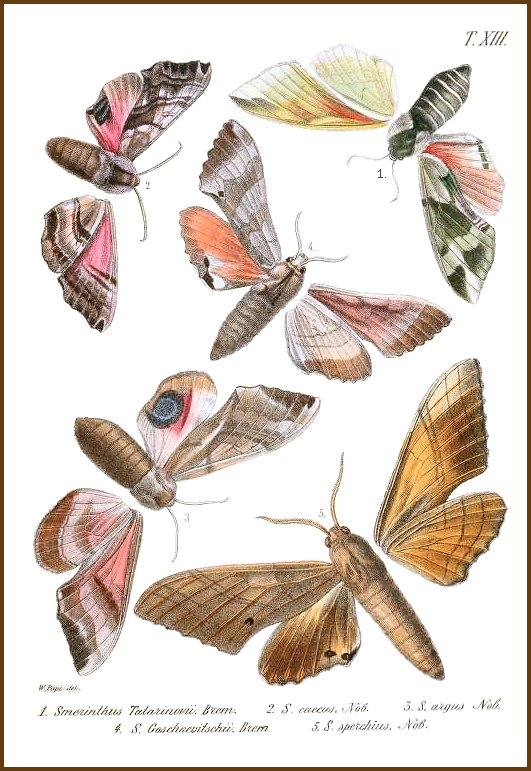
Holarctic; eastern Palaearctic region. Pleistocene refuge: Polycentric -- Manchurian, Japanese, Sinopacific, Sinotibetan and Yunnan refugia.
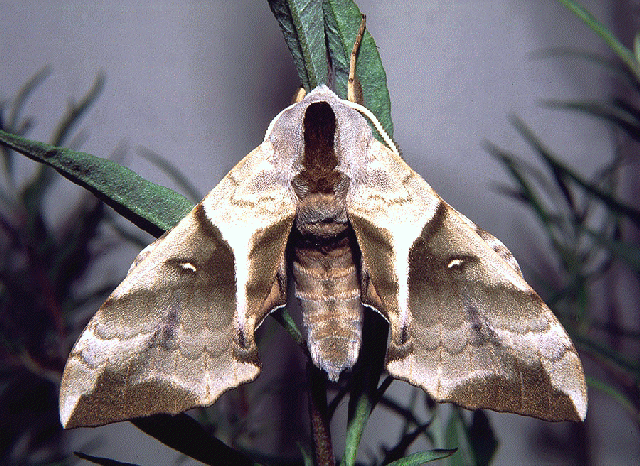
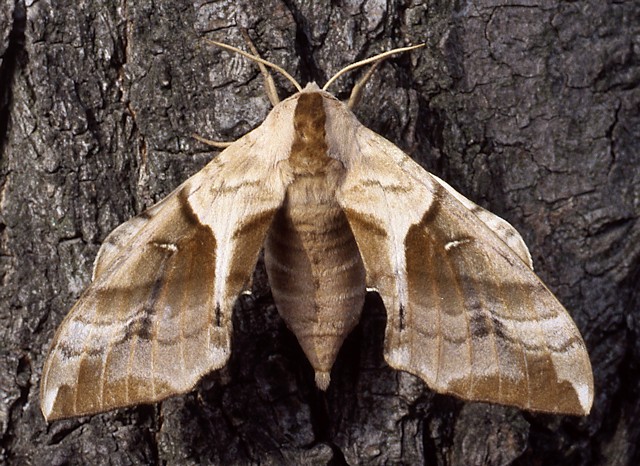
Wingspan: 70--100mm. Like a large version of Smerinthus ocellatus. Spring brood individuals are the smallest, those which emerge in September or even October are much larger. Developing pupae exposed to cool conditions produce greyer adults than those kept drier and warmer. Imagines from the latter tend to be much paler and browner.
The defensive 'glaring eye' posture is more exaggerated in this species than it is in Smerinthus ocellatus. Smerinthus planus also drops to the ground more readily on being disturbed. Emergence takes place just after dark, with females calling for a short period around midnight. Pairing is a short affair, rarely lasting for more than a few hours; the pair usually part before morning. Egg-laying often commences on the same night immediately after pairing.
Females of this species will readily attract wild males of Smerinthus ocellatus in Europe, with the resulting eggs being fertile and the larvae vigourous. However, only male hybrid pupae hatch, usually at the same time as the Smerinthus planus parent. These hybrid males do not respond to calling females of Smerinthus planus; it is not known if they will respond to those of Smerinthus ocellatus.
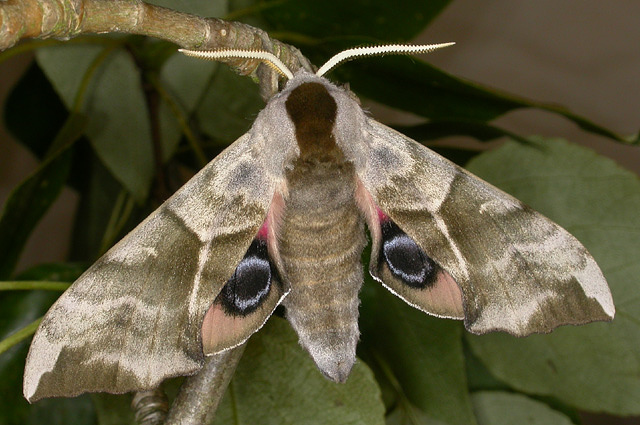
Probably bivoltine in western China; the single specimen (in the collection of the Shihezi Agricultural College) from the Yili area of Xinjiang Province, China, was captured on 24 IV 1982 (Pittaway & Kitching, 2000). Depending on latitude and weather, there are between one and four generations farther east in China, with adults on the wing between April and September. Two are normal in Beijing and Ningxia, three in southern Shaanxi, four in Jiangsu and Jianxi.
OVUM: Oval, very shiny, pale green (1.9 x 1.6mm), becoming greyish white prior to hatching. Laid singly or in pairs beneath leaves not more than 2m above the ground.
LARVA: Full-fed: 75--90mm. Dimorphic: bluish green or apple-green.
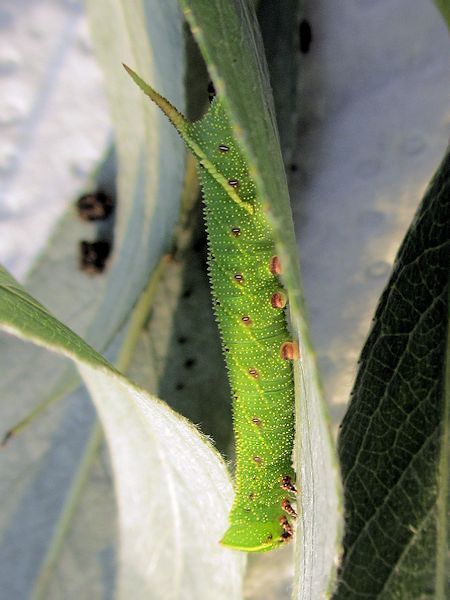
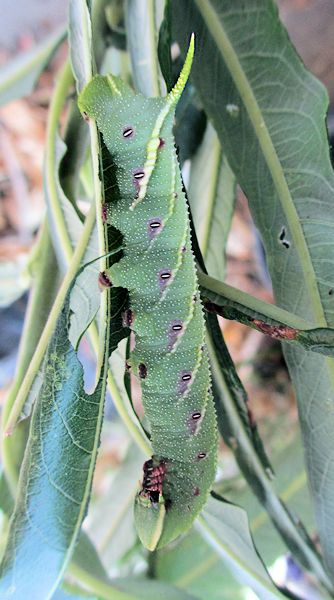
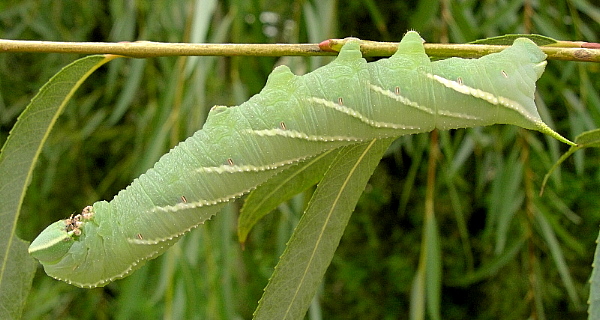
On emergence, the young larva is about 6mm long, pale whitish green, with a reddish-black horn. It clings tightly with all legs to a vein on the underside of a leaf. In the second instar, pale lateral stripes appear, the head becomes dorsally pointed and, when not feeding, it rests in a typical sphinx-like posture, holding on with the last three pairs of prolegs only. When so positioned beneath a leaf, the larva is very difficult to detect due to its excellent counter-shading.
The fully-grown larva resembles that of Smerinthus ocellatus in both behaviour and morphology; however, the body tubercles are more coarse, the white lateral stripes more bold and the horn less blue.
As with Smerinthus ocellatus, many larvae in a colony may perish in any one year due to parasitoids, such as Microplitis ocellatae Bouché, 1834.
Hostplants. Most species of Populus and Salix, with the former being preferred.
PUPA: 41--48mm. Indistinguishable from that of Smerinthus ocellatus.
Ichneumonidae: Callajoppa exaltatoria (Panzer, 1804), Callajoppa lutoria (Fabricius, 1787), Netelia vinulae (Scopoli, 1763) [syn. Netelia cephalotes (Holmgren, 1860)]; Braconidae: Aleiodes praetor (Reinhard, 1863), Cotesia affinis (Nees, 1834) [syn. Cotesia planus (Watanabe, 1932)], Cotesia suzumei (Watanabe, 1932), Microplitis ocellatae Bouché, 1834; Tachinidae: Compsilura concinnata (Meigen, 1824), Exorista sorbillans (Wiedemann, 1830), Winthemia angusta Shima, Chao & Zhang, 1992.
The Ili River valey of eastern Kazakhstan (Toropov, Milko, Zhdanko & Evdoshenko, 2023); Western Xinjiang Province, China (Pittaway & Kitching, 2000).
The occurrence of Smerinthus planus on the China-Kazakhstan border (Ili/Yili area) extends considerably the westward distribution of this eastern Palaearctic species. This has probably come about due to the extensive planting of Populus and Salix trees across northern China, forming a habitable corridor which Smerinthus planus has exploited. Callambulyx tatarinovii tatarinovii has also reached the same area by the same means.
Extra-limital range. From eastern Kazakhstan and northern Xinjiang across northern China, Mongolia, southern eastern Siberia (Izerskiy, 1999) to the Russian Far East (Kunashir Island) and Japan, and then south through Korea and Taiwan to Hainan, Yunnan and eastern Xizang/Tibet, China.
 Return to species list
Return to species list